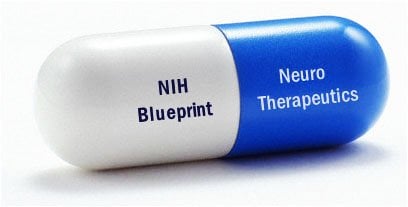New projects will target Fragile X syndrome, nicotine addiction, and age-related macular degeneration.
The National Institutes of Health has launched three innovative projects that will focus on development of therapeutics for Fragile X syndrome, nicotine addiction, and age-related macular degeneration (AMD). These projects are funded through the NIH Blueprint Neurotherapeutics Network which provides access to a variety of drug development resources.
“We are excited about the opportunity to apply cutting-edge science to the pursuit of novel treatments for these debilitating disorders” said Rebecca Farkas, Ph.D., program director at NIH’s National Institute of Neurological Disorders and Stroke (NINDS), Office of Translational Research.
The purpose of the NIH Blueprint is to provide in-depth research capabilities to increase the success rate of innovative drug discovery efforts. The program uses a virtual pharma model to provide researchers with access to support and resources that have been traditionally available to large pharmaceutical companies.

Partnerships between NIH program staff and awarded research teams are designed to bridge the funding gap between ground-breaking laboratory research and industry adoption. NIH staff helps investigators work with veteran industry drug development consultants and contract research organization capabilities from the discovery stage through preliminary clinical trials. In addition, each investigator maintains sole ownership of intellectual property associated with his or her project
NIH launched the Blueprint Neurotherapeutics Network in 2011. Including these three awards, 14 drug discovery programs have been funded as part of the program and 10 are currently active.
The newly-funded investigators and their organizations are:
- Sage Therapeutics, Cambridge, Mass.
Principal Investigator: Al Robichaud, Ph.D.
Disorder: Fragile X syndrome
Project Summary: Fragile X syndrome is a genetic disorder linked to a range of neurodevelopmental disorders including learning disabilities and cognitive impairment. Many patients experience general and social anxiety yet benzodiazepines, which are drugs typically used to treat anxiety disorders, provide little relief. Their anxiety has been linked to reduced activity in the brain by a protein called, the GABA A receptor. Sage Therapeutics is developing positive allosteric modulators, designed to enhance the receptor’s activity and possibly relieve the anxiety. - The Scripps Research Institute, Jupiter, Fla.
Principal Investigator: Paul J. Kenny, Ph.D.
Disorder: nicotine addiction
Project Summary: Nicotine addiction has been attributed to the stimulatory effects of nicotine binding to brain proteins called orexin 1 receptors. Dr. Kenny and colleagues will develop selective receptor antagonists as potential smoking cessation aids to treat people who have attempted to quit smoking but faced high relapse rates and significant side effects. - University of Utah, Salt Lake City
Principal Investigator: Dean Yaw Li, Ph.D.
Disorder: age-related macular degeneration
Project Summary: Age-related macular degeneration is a leading cause of blindness in the United States. One form, called wet AMD, is associated with inflammation and blood vessel leakage in the retina, the eye’s light-sensitive tissue. Dean Li and his colleagues are developing small molecules that inhibit the activity of Arf6, a molecule known to help control inflammation and blood vessel leakage. This novel approach may lead to effective therapies for treating patients who do not respond to current wet AMD therapies.
Notes about this neurological drug development project article
Contact: Christopher Thomas – NIH/NINDS
Source: NIH/NINDS press release
Image Source: The image is credited to NIH/NINDS and is adapted from the press release.







